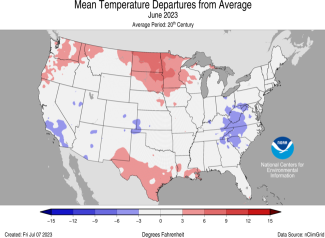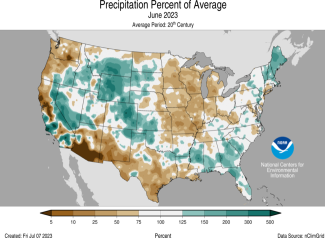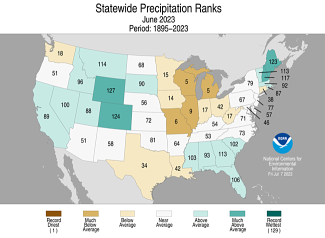Record-breaking heat waves hit portions of the U.S. during June

Key Points:
- Heat waves impacted the southern Plains, Northeast and Puerto Rico this month, breaking temperature records and creating life-threatening conditions.
- A total of 12 billion-dollar weather and climate disasters have been confirmed this year. These disasters consisted of 10 severe storm events, one winter storm and one flooding event.
- Thick smoke from Canadian wildfires created air quality issues for millions in portions of the Northeast and Great Lakes this June.
- Portions of the Midwest experienced dry soils, low streamflow and distressed crops in June. Missouri, Illinois, Wisconsin and Michigan each ranked in the top-10 driest June on record.
- Much of the eastern U.S. had a warm start to 2023 with 29 states experiencing a top-10 warmest January–June including Florida which ranked warmest on record.
- In June, the average temperature and precipitation for the contiguous U.S. ranked in the middle third of the historical record.
Other Highlights:
Temperature
The average temperature of the contiguous U.S. in June was 69.0°F, 0.5°F above average, ranking in the middle third of the 129-year record. Generally, June temperatures were below average from California to the central Plains and across much of the Mid-Atlantic and Southeast. Temperatures were above average from the Northwest to the northern Plains, as well as in the southern Plains and Florida Peninsula. North Dakota ranked third warmest on record for June while two additional states ranked among their top-10 warmest on record. Conversely, West Virginia and Virginia had their ninth- and 10th-coldest June on record, respectively.
The Alaska statewide June temperature was 50.0°F, 0.8°F above the long-term average, ranking in the middle third of the 99-year period of record for the state. Above-normal temperatures were observed across the Aleutians and in parts of the North Slope and the Southeast during the month while small pockets of below-average temperatures were observed in interior portions of the state.
For the January–June period, the average contiguous U.S. temperature was 49.2°F, 1.7°F above average, ranking 21st warmest on record for this period. Temperatures were above average from the southern Plains to the East Coast and along parts of the Northern Tier, with near- to below-average temperatures from the northern Plains to the West Coast. Florida ranked warmest on record while Massachusetts had its second-warmest January–June period. An additional 27 states had a top-10 warmest year-to-date period. No state experienced a top-10 coldest event for this six-month period.
The Alaska January–June temperature was 22.8°F, 1.5°F above the long-term average, ranking in the middle third of the historical record for the state. Much of the state was near normal for the six-month period while temperatures were above average across much of the North Slope and in parts of the southeast, Kodiak Island and the Aleutians.
Precipitation
June precipitation for the contiguous U.S. was 2.85 inches, 0.08 inch below average, ranking in the middle third of the historical record. Precipitation was above average across much of the West and in parts of the Southeast and New England. Precipitation was below average across much of the Midwest and in parts of the Northwest, Southwest, southern Plains, Mid-Atlantic and southern New England. Wisconsin and Michigan each had their fifth-driest June on record, while two additional states had their top-10 driest June on record. Conversely, Wyoming ranked third wettest with two additional states ranking among their top-10 wettest June on record.
Across the state of Alaska, the average monthly precipitation was 2.85 inches, making last month the 19th-wettest June in the 99-year record. Conditions were wetter than average across most of the state while parts of the Northeast, Southwest and Panhandle were near normal and parts of the Southeast Interior and Aleutians observed below-normal precipitation during the month.
The January–June precipitation total for the contiguous U.S. was 15.70 inches, 0.39 inch above average, ranking in the middle third of the 129-year record. Precipitation was above average from California to the western Great Plains and in parts of the southern Mississippi Valley, northern Great Lakes, Southeast and Northeast. Conversely, precipitation was below average across parts of the Northwest, northern and central Plains, Southwest, central Mississippi Valley, Mid-Atlantic and along parts of the Gulf during the January–June period. Maryland had its fourth-driest January–June on record.
The January–June precipitation ranked 14th wettest in the 99-year record for Alaska, with above-average precipitation observed across much of the state. Precipitation was near average in parts of south-central Alaska and along the Gulf of Alaska coast while below-average precipitation was observed in part of the Aleutians during this period.
Billion-Dollar Disasters
Three new billion-dollar weather and climate disasters were confirmed this month, two of which occurred during the month of May. All of these disasters were severe storm events.
For 2023 to-date, 12 weather and climate disasters have losses exceeding $1 billion. These disasters consisted of 10 severe storm events, one winter storm and one flooding event. The total cost of these events exceeds $32.7 billion (CPI-adjusted), and they have resulted in 100 direct and indirect fatalities. For this year-to-date period, the first six months of 2023 rank second-highest for disaster count, behind 2017 with 14 disasters and behind 2021 which had $42.5 billion in terms of total cost.
The very active U.S. severe storm season is reflected in the high count of billion-dollar events that have produced destructive tornadoes, severe hail and high wind across much of the central and eastern U.S.
The 1980–2022 annual average is 8.1 events (CPI-adjusted); the annual average for the most recent five years (2018–2022) is 18.0 events (CPI-adjusted).
Since these billion-dollar disaster records began in 1980, the U.S. has sustained 360 separate weather and climate disasters where overall damages/costs reached or exceeded $1 billion (based on the CPI adjustment to 2023) per event. The total cost of these 360 events exceeds $2.570 trillion.
Other Notable Events
A series of heat waves brought record-breaking temperatures to portions of the U.S. during June:
- An early June heat wave brought life-threatening conditions to Puerto Rico as heat indices reached as high as 125°F. On June 6, San Juan set a new daily high temperature record of 95°F.
- A heat wave brought record heat to portions of the Northeast, Mid-Atlantic and Great Lakes during early June. Daily temperature records were set in parts of Michigan, New York and Vermont.
- A heat wave caused temperatures to soar well above 100°F across parts of the southern Plains. In Texas, the cities of Del Rio and Rio Grande reached 113°F and San Angelo reported 114°F on June 20, setting the all-time heat record at each location. On June 24, the temperature at Rio Grande Village, Texas, topped out at 119°F–1°F below the all-time temperature record for the state.
Smoke from Canadian wildfires caused significant air quality issues in parts of the U.S. during June:
- On June 7, around 100 million people across 16 states were under air quality alerts while New York City reported the worst air quality of major cities worldwide.
- On June 27, wildfire smoke impacted a large portion of the Midwest, resulting in the city of Chicago having the worst air quality of major cities worldwide.
Drought
According to the July 4 U.S. Drought Monitor report, about 27.0% of the contiguous U.S. was in drought, up about 8.0% from the end of May. Moderate to exceptional drought was widespread across much of the Great Plains, with moderate to extreme drought in much of the Midwest. Moderate to severe drought was present in parts of the Northwest, northern Rockies, Southwest, Mid-Atlantic, Hawaii and Puerto Rico as well as moderate drought in parts of the southern Mississippi Valley and Florida Peninsula.
Drought or abnormally dry conditions expanded or intensified in parts of the Northwest, eastern Plains, Mississippi River Valley, Great Lakes, Northeast, Alaska, Hawaii and Puerto Rico this month. Drought contracted or was reduced in intensity across interior parts of the West, the western Great Plains, and parts of the Ohio and Tennessee valleys, Florida Peninsula and Northeast.
Monthly Outlook
According to the June 30 One-Month Outlook from the Climate Prediction Center, areas from Arizona to the East Coast and in parts of the Northwest, Great Lakes and northeast Alaska favor above-normal monthly average temperatures in July, with the greatest odds in parts of the southern Plains. The best chances for below-normal temperatures are forecast for parts of the central Rockies, northern Plains and in parts of southwest Alaska. Much of the Plains to the Northeast, as well as parts of northern and eastern Alaska are favored to see above-normal monthly total precipitation while below-normal precipitation is most likely to occur in parts of the Southwest. Drought improvement or removal is forecast from the central Plains to the southern Great Lakes and in parts of the Northeast, southern Louisiana and Puerto Rico, while persistence is more likely in portions of the Northwest, Southwest, southern Plains, northern Great Lakes and parts of the central Plains and Hawaii. Drought development is likely in parts of the Northwest, southern Plains, Great Lakes and Hawaii.
According to the One-Month Outlook issued on July 1 from the National Interagency Fire Center, Hawaii and portions of the Northwest, northern Great Lakes and Southwest have above-normal significant wildland fire potential during July, while parts of California, New Mexico and Alaska are expected to have below-normal potential for the month.
This monthly summary from NOAA’s National Centers for Environmental Information is part of the suite of climate services NOAA provides to government, business, academia and the public to support informed decision-making. For more detailed climate information, check out our comprehensive June 2023 U.S. Climate Report scheduled for release on July 14, 2023. For additional information on the statistics provided here, visit the Climate at a Glance and National Maps webpages.









